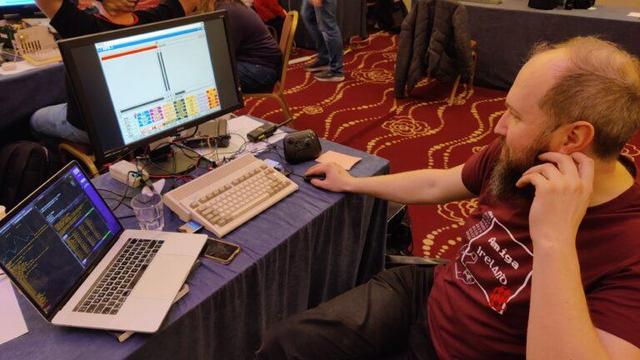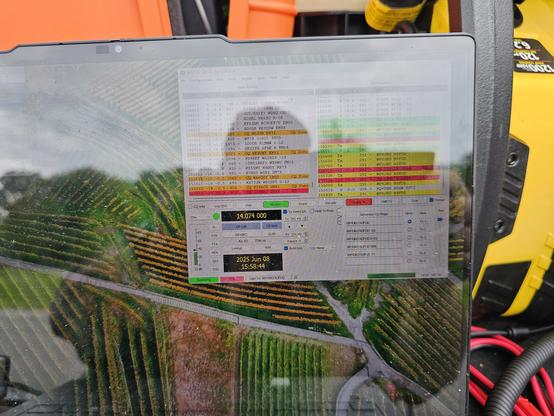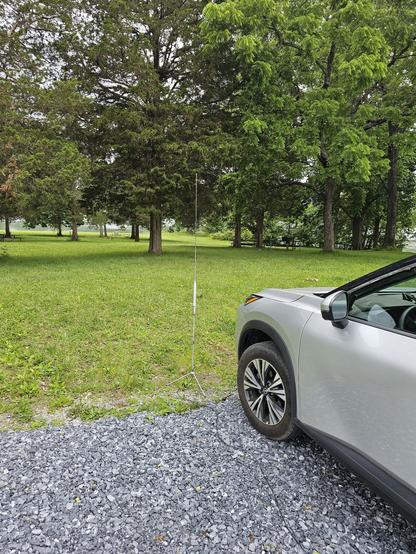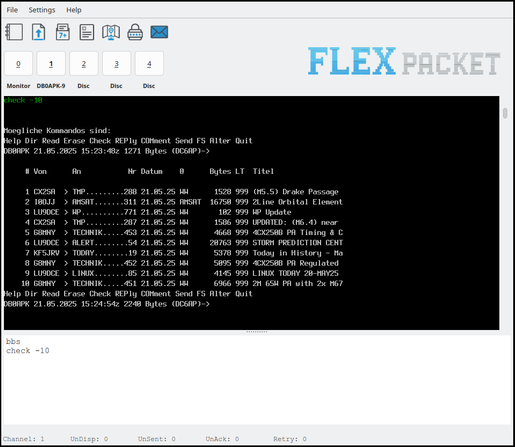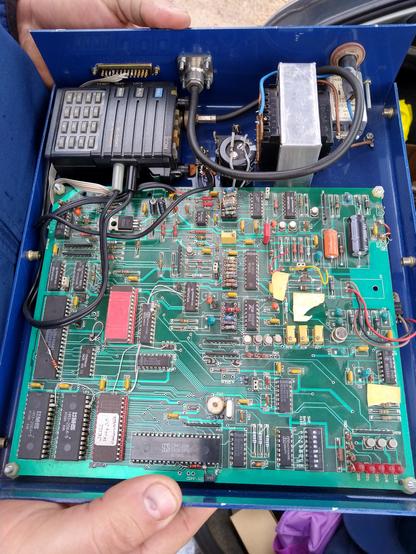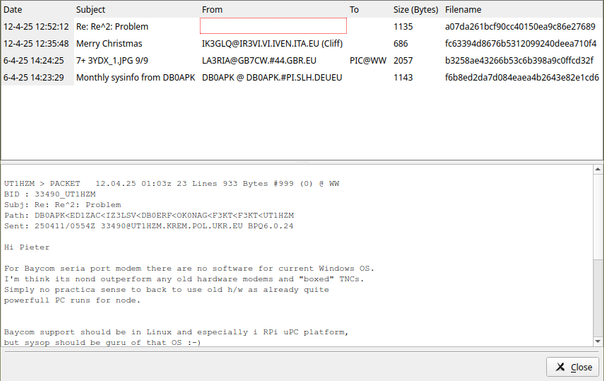🛠️ 14:00 Packet Radio for a New Generation: by Ben EI9IUB
From retro-tech to resilient comms packet radio is back with a modern mission
Explore mesh networks, APRS, & plans for a new Irish packet network. https://www.tog.ie/2025/06/%f0%9f%93%bb-radio-day-at-tog-hackerspace-saturday-june-14th/
#RadioDay #PacketRadio #HamRadio #MeshNetworking
#packetRadio
Good... afternoon y'll!! Out and about today. Got up at 0730 and decided I was not going to spend the entire day doing chores and such.
Drove out to a local state park (Gifford Pinchot State Park) to play radio. Since I developed my radio go kit, I decided to test everything out, HF and VHf. Started with packet radio, trying to make contact with my home BBS over VHF frequencies; no connection. Went through digital repeaters with minimal trouble, but then the BBS went wonky. One VPN and SSH connection later, I reset the BBS and made connections on multiple frequencies. Woo Hoo!
Next up was the HF radio and FT8, a weak signal communications mode. I've made a few contacts at 25 watts on the portable vertical antenna. Decided not to stretch out the NVIS dipole as there are too many kids running around and I don't want one of them running into the wires. Next time I'll find a spot a little less populated.
So far so good. I got out of the apartment, it's not hot or humid out, and I've only gotten rained on a little bit. Keeping an eye on the weather, because it takes about a half hour to get the stuff back in the car.
Trying not to engage with all of the CA crap going on right now. As soon as I heard the deployment of NG troops, my mind immediately went to the move "The Siege." Not good.
Stay safe and LET'S BE CAREFUL OUT THERE!!
#amateurradio #hamradio #ft8 #packetradio
@firefly @BakerRL75 @@czarbucks @@amyedge @ai6yr @Jennifer @AE4WX @technodad
I've released FlexPacket in Version 0.6.0. 🥳
Looks like WINTNC is coming to #linux ! ncurses based for that old school vibe. WINTNC is a KISS #packetradio node, bbs and terminal.
https://groups.io/g/WINTNC/topic/113349289
I small introduction of the current FlexPacket version on my #hamradio blog. There you will also find the latest AppImage for Linux. And yes, I changed the look and feel. 🙂
Hamfest packet radio goodie.
Suspected to be from the former Finnish packet radio network.
1200baud 1200MHz band backhaul link with TAPR TNC-2 clone.
Building an AX.25 Messenger App with C#, a TNC, and a Bit of Madness
1,046 words, 6 minutes read time.
YT MD-UV390 Digital Dual Band VHF UHF DMR Radio Waterproof Dustproof IP67 Walkie TalkieIt started with a simple idea — or at least it seemed simple. I was chatting with AI about ways to send text messages from device to device using nothing but the speakers and microphones already built into our phones or laptops. The idea was to modulate the data into frequencies just outside the human hearing range and transmit them. AI made it sound easy — encode, send, decode. But once I actually started trying to do it, it quickly became clear: it wasn’t simple at all. It wasn’t even close.
That failure wasn’t the end — it was the beginning. Because during that process, I remembered that I already owned something built for this kind of thing: a Mobilinkd TNC3. It connects via Bluetooth or USB, speaks the AX.25 protocol over KISS, and communicates via AFSK. And so, a new plan was born — use existing amateur radio tech to send messages between devices. But I didn’t just want to use the TNC — I wanted to understand what it was doing. That meant learning AX.25, digging into KISS, and writing everything from scratch in C#.
The Stack: Tools and Hardware
For this build, I used:
- C# as the language of choice.
- A Mobilinkd TNC3, connected via USB.
- A TYT MD-UV390 radio, operating in analog mode.
- Cables to connect the TNC to the Radio.
Why AX.25?
The Mobilinkd TNC3 operates using the AX.25 protocol layered over KISS. If you want to send messages through this hardware, you have to understand those protocols. AX.25, originally developed for packet radio in amateur radio use, is efficient, compact, and battle-tested.
I dove into it because the hardware required it — but what I found was something elegant. The structure is simple enough to understand but flexible enough to do real work. That said, actually implementing it in C# was another story.
Writing the AX.25 Messenger
The goal of the app was simple: send and receive short text messages over radio using the Mobilinkd TNC3 and AX.25 protocol.
The project is open source. You can find the code here:
👉 GitHub Repository: AX25Messenger
Let’s walk through some of the key components.
1. Encoding an AX.25 Frame
Here’s what the code looks like when we build the raw AX.25 frame. We start with destination and source callsigns, then add control and protocol fields, and finally append the actual payload.
public byte[] CreateAX25Frame(string destination, string source, byte[] payload){ var frame = new List<byte>(); // Encode callsigns frame.AddRange(EncodeCallsign(destination, false)); frame.AddRange(EncodeCallsign(source, true)); // Control field (0x03 = UI frame) frame.Add(0x03); // Protocol ID (0xF0 = no layer 3 protocol) frame.Add(0xF0); // Add payload frame.AddRange(payload); return frame.ToArray();}This code constructs the complete AX.25 frame for a UI (Unnumbered Information) packet. The EncodeCallsign method handles shifting and bit manipulation, making it compatible with the standard.
2. Interfacing with the TNC over KISS
KISS is a framing protocol that wraps the AX.25 data for transmission over a serial port. Here’s how we encapsulate an AX.25 frame into a KISS frame.
public byte[] WrapKISSFrame(byte[] ax25Frame){ var kissFrame = new List<byte>(); kissFrame.Add(0xC0); // Start delimiter kissFrame.Add(0x00); // Command byte: TNC Data frame foreach (var b in ax25Frame) { if (b == 0xC0) { kissFrame.Add(0xDB); kissFrame.Add(0xDC); } else if (b == 0xDB) { kissFrame.Add(0xDB); kissFrame.Add(0xDD); } else { kissFrame.Add(b); } } kissFrame.Add(0xC0); // End delimiter return kissFrame.ToArray();}This makes the AX.25 message digestible by the TNC.
3. Sending the Data
Once the KISS frame is ready, it’s sent out the serial port like this:
_serialPort.Write(kissFrame, 0, kissFrame.Length);Where _serialPort is an instance of SerialPort in .NET. Simple, fast, and effective.
The Frustrations of Learning While Building
There were many moments during this project that made me want to throw the whole setup out the window. Trying to learn AX.25 and KISS while building an app around them is painful. The documentation is scattered, and much of what’s out there is old, inconsistent, or assumes a Linux environment.
It didn’t help that most of the time, you can’t even tell if your code is broken or if the radio just didn’t key up fast enough. Debugging means digging into the bits of a failed frame, then trying again and hoping for a clean transmission.
And then there’s AI — which was extremely helpful in doing early code research, mocking up skeletons, and pointing me toward technical docs. But it also hallucinated like crazy when it came to niche protocols. AI tends to guess at how it should be coded when it doesn’t have enough training data, and this project was definitely in that category. I had to train the AI by teaching it the protocol myself before it became useful.
What Didn’t Work
One major limitation of this build: I wasn’t able to test incoming AX.25 messages yet. That part of the project is still under construction. The receive pipeline, decoding the AX.25 frame, and confirming messages are cleanly parsed is a work in progress. It’s the next big hurdle.
Conclusion: A Love Letter to Low-Level Protocols
This whole build was a reminder that sometimes the best learning comes from the weirdest places. I didn’t plan to learn how AX.25 worked. I definitely didn’t plan to write a whole C# interface to a hardware modem. But here we are.
This was a project of persistence, curiosity, and a refusal to let a good idea die. If you’re into coding, radios, or just learning things the hard way, I can’t recommend it enough.
Follow the project on GitHub: AX25Messenger.
And if you enjoyed this write-up or want to follow along as I dive deeper into protocols, microcontrollers, or strange networking ideas, be sure to subscribe to the newsletter.
D. Bryan King
Sources
- AX.25 Link Access Protocol Specification (Version 2.2)
- Mobilinkd TNC3 User Guide
- KISS Protocol Overview
- AFSK Demodulation Explained
- AX.25 Protocol Implementation in C
- AX.25 Layer 2 Protocol Resource
- AFSK Modulation Overview – SatNOGS Wiki
- Mobilinkd Official Website
- The KISS TNC Protocol Specification
- KISS, HDLC, AX.25 and Friends – Daniel Estévez
- Python KISS Protocol Implementation
- Modern Introduction to Packet Radio, AX.25, APRS, and TCP/IP
- Frequency-Shift Keying – Wikipedia
- AX.25 in Winlink Global Radio Email
- Network Access using AX.25 over VHF Amateur Radio
Disclaimer:
The views and opinions expressed in this post are solely those of the author. The information provided is based on personal research, experience, and understanding of the subject matter at the time of writing. Readers should consult relevant experts or authorities for specific guidance related to their unique situations.
Related Posts
- Exploring the Different Modes of Communication in Amateur Radio Date August 21, 2024
- The Powerful World of Automatic Packet Reporting System in Amateur Radio Date September 11, 2024
- The BBS Botnet: The Hidden Cybersecurity Crisis in Ham Radio Date October 2, 2024
#AFSKModem #AIInRadioProjects #AmateurRadio #amateurRadioTNC #APRSMessaging #AX25 #AX25CCode #AX25Examples #AX25ForProgrammers #AX25LearnByCoding #AX25RawFrames #AX25WithMobilinkd #AX25CMessenger #AX25DigitalMode #AX25Modem #AX25ParserC_ #AX25Protocol #ax25TestSetup #buildingAX25Apps #CAFSKDecoding #CAndKissProtocol #CAndPacketRadio #CAX25 #CHamToolkit #CProjectAX25 #CRadioApp #digitalModeCCode #digitalRadioMessage #hamRadioAndProgramming #hamRadioCExamples #hamRadioCoding #hamRadioCodingTutorial #hamRadioProgramming #hamRadioProtocol #kissAndAfsk #kissCProtocol #kissDecoderTutorial #kissInterface #KISSProtocol #kissProtocolC_ #kissProtocolExample #kissTnc #learnAX25 #learningPacketRadio #MobilinkdTNC3 #packetRadio #packetRadioDev #packetRadioOverAudio #radioMessageApp #radioTextOverAfsk #radioToRadioMessaging #realTimeRadioMessaging #serialRadioCommunication #TNC3AndKiss #TNC3HardwareGuide
A silly protocol idea has been brewing in my mind… CoAP over AX.25.
The thinking is this… use UI frames to encapsulate CoAP messages in the same manner as UDP and use a URI scheme like coap+ax25://DEST[,DIGI1[,DIGI2…]]/[path]
If DEST has the C/H bit clear, DEST is a "multicast" group, otherwise it's a specific amateur station.
File transfer just uses RFC-7959 [block-wise transfer] (with possibly a small extension inspired by RFC-2090 [TFTP Multicast] to allow Block1 transmissions to a multicast group).
That would allow file transfer and messaging between stations using existing AX.25 packet radio hardware.
- https://datatracker.ietf.org/doc/html/rfc7252 - CoAP RFC
- https://datatracker.ietf.org/doc/html/rfc7959 - Blockwise transfers over CoAP
- https://datatracker.ietf.org/doc/html/rfc2090 - TFTP Multicast
- https://ax25.net/ - AX.25 protocol specs and docs
Are there any ham radio packet BBS systems that I can connect to via the Internet? Ideally East Coast US.
I don't have the ability to connect to packet nodes local to me. My ham shack is down pending remodeling. I'd still like to poke around from a Linux box over SSH or Telnet if I can just to see what it's like.
For all you #PacketRadio folks, checking to see that my whitepages entry is working.
can someone send me a packet message to:
KB8QPT
Thanks!
It looks like APRS has competition in the form of the CATS protocol. https://cats.radio/
Is there a node map, equivalent to aprs.fi for this protocol?
I am mulling over creating a website and a #GeminiCapsule for those interested in getting started in #PacketRadio . I was thinking that it might be cool to be able to post a listing to the #PacketBBS and allow users to request info via packet, but proxy through #Gemini
This should be possible, as my node can play #Zork
with the latest changes, 7Plus works very well with my flexpacket #packetradio terminal. 🥳
🚀 Oh joy, another "lightweight" protocol to complicate your life with packet radios! Because what we really needed was yet another GitHub project with a name only a tech hipster would love—MeshCore. 🤦♂️ But hey, at least you get to "automate any workflow" while drowning in #buzzwords.
https://github.com/ripplebiz/MeshCore #lightweightprotocol #packetradio #MeshCore #automation #HackerNews #ngated
I've add a new feature in Flexpacket. Flexpacket will store chosen mails automatically therefore we can read them later offline. Thats a helpfull feature for very long mails. :-) I've tested it with OpenBCM. If it's not working with your home PBBS, please open an issue and add the whole Mail (include header data). 😀 #hamradio #packetradio #ax25
In other news, a copy of Jan Axelson’s “USB Complete” 5th edition arrived today. Hoping it can help me make sense of USB Audio 2, so I can make progress on my #RaspberryPiPico project! #PacketRadio #Embedded #HamRadio
I just set up a node too, after 35 years away from #PacketRadio
if you want to try and send a message,my address is:
KB8QPT@KD8FTR.#NEOH.OH.USA.NOAM
thanks!
I think i have a working #HomeBBS on VHF #PacketRadio.
If someone wants to send me a bbs message, that would be awesome. My address is:
KB8QPT@KD8FTR.#NEOH.OH.USA.NOAM
if you post your address, I'll try sending you a message.
thanks!
So, I am finally updating my #GeminiCapsule #Gemlog .
This time, it's about getting my #PacketRadio station put back up for the first time since like 1992. it works!
But this posting makes me wonder about the present state of the #Gemini protocol. More later.
gemini://gemini.sergio101.com/posts/fun-with-packet-radio.gmi
